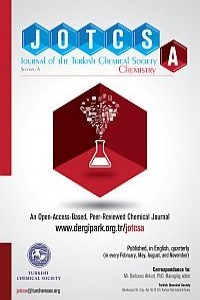Adsorption Of Metamizole Sodium By Activated Carbon In Simulated Gastric And Intestinal Fluids
In vitro adsorption of metamizole sodium by activated carbon was studied at pH 1.2 and 7.5 in order to simulate gastric and intestinal fluids. In the first 5 minutes, more than eighty percent of the total adsorption occurred but the adsorption process achieved to the equilibrium in 1 hour. Time to reach equilibrium was not changed with the changing pH, concentration of the adsorbate or the adsorbent amount. The equilibrium data followed the Langmuir model and therefore fitted to L-type in accordance with the Giles classification for adsorption isotherms. The maximum removal capacities of the activated carbon for metamizole sodium were calculated using Langmuir equation and found as 185.19 mg/g and 161.29 mg/g at pH 1.2 and 7.5, respectively.
Keywords:
Adsorption, Metamizole sodium, Gastric fluid, Intestinal fluid Dipyrone,
___
- 1. Bentur Y, Cohen O. Dipyrone Overdose, Journal of Toxicology: Clinical Toxicology 2004; 42(3): 261-265.
- 2. Bar-Oz B, Bulkowstein M, Benyamini L, Greenberg R, Soriano I, Zimmerman D, Bortnik O, Berkovitch M. Use of antibiotic and analgesic drugs during lactation. Drug safety. 2003 Nov 1;26(13):925-35.
- 3. Otero M, Grande CA, Rodrigues AE. Adsorption of salicylic acid onto polymeric adsorbents and activated charcoal, Reactive & Functional Polymers 2004; 60: 203–213.
- 4. Çalışkan E, Göktürk S. Adsorption characteristics of sulfamethoxazole and metronidazole on activated carbon. Separation Science and Technology. 2010 Jan 29;45(2):244-55.
- 5. ÇalışkanSalihi E, Aydın E. Adsorptive characteristics of isoniazid on powdered activated carbon: π–π Dispersion interactions at the solid–solution interface. Journal of Dispersion Science and Technology. 2017 Apr 3;38(4):457-62.
- 6. Removal of ethacridine lactate from aqueous solutions onto bentonite and activated carbonRYCantürkTalman, E ÇalışkanSalihi, S Göktürk, AS Baştuğ FRESENIUS ENVIRONMENTAL BULLETIN 24 (11), 3603
- 7. Kyzas GZ, Lazaridis NK, Deliyanni EA. Oxidation time effect of activated carbons for drug adsorption. Chemical engineering journal. 2013 Dec 31;234:491-9.
- 8. Kyzas GZ, Deliyanni EA. Modified activated carbons from potato peels as green environmental-friendly adsorbents for the treatment of pharmaceutical effluents. Chemical Engineering Research and Design. 2015 May 31;97:135-44.
- 9. Jain S, Vyas RK, Pandit P, Dalai AK. Adsorption of antiviral drug, acyclovir from aqueous solution on powdered activated charcoal: kinetics, equilibrium, and thermodynamic studies. Desalination and Water Treatment. 2014 Jul 29;52(25-27):4953-68.
- 10. Bajpai SK, Bhowmik M. Poly (acrylamide-co-itaconic acid) as a potential ion-exchange sorbent for effective removal of antibiotic drug-ciprofloxacin from aqueous solution. Journal of Macromolecular Science, Part A. 2010 Dec 29;48(2):108-18.
- 11. Guedidi H, Reinert L, Lévêque JM, Soneda Y, Bellakhal N, Duclaux L. The effects of the surface oxidation of activated carbon, the solution pH and the temperature on adsorption of ibuprofen. Carbon. 2013 Apr 30;54:432-43.
- 12. Baccar R, Sarrà M, Bouzid J, Feki M, Blánquez P. Removal of pharmaceutical compounds by activated carbon prepared from agricultural by-product. Chemical engineering journal. 2012 Nov 15;211:310-7.
- 13. Nabais JV, Mouquinho A, Galacho C, Carrott PJ, Carrott MR. In vitro adsorption study of fluoxetine in activated carbons and activated carbon fibres. Fuel Processing Technology. 2008 May 31;89(5):549-55.
- 14. Giles, C.H., MacEwan, T.H., Nakhwa, S.N. and Smith, D.J. (1960) J. Chem. Soc., 786: 3973-3993.
- 15. Langmuir I. The adsorption of gases on plane surfaces of glass, mica and platinum. Journal of the American Chemical society. 1918 Sep;40(9):1361-403.
- 16. Freundlich H. Über die adsorption in lösungen. Zeitschrift für physikalische Chemie. 1907 Oct 1;57(1):385-470.
- 17. Myers, D. (1999) Surfaces, Interfaces, and Colloids: Principles and Applications; New York: John Wiley & Sons, Inc.
- 18. Marra MC, Silva PL, Muñoz RA, Richter EM. Ultra-fast determination of scopolamine, orphenadrine, mepyramine, caffeine, dipyrone, and ascorbic acid by capillary electrophoresis with capacitively coupled contactless conductivity detection. Journal of the Brazilian Chemical Society. 2014 May;25(5):913-9.
- 19. Wu Y, Xi B, Hu G, Wang D, Li A, Zhang W, Lu L, Ding H. Adsorption of tetracycline and sulfonamide antibiotics on amorphous nano-carbon. Desalination and Water Treatment. 2016 Oct 7;57(47):22682-94.
- 20. Ji L, Chen W, Zheng S, Xu Z, Zhu D. Adsorption of sulfonamide antibiotics to multiwalled carbon nanotubes. Langmuir. 2009 Sep 3;25(19):11608-13.
- 21. Gao Y, Li Y, Zhang L, Huang H, Hu J, Shah SM, Su X. Adsorption and removal of tetracycline antibiotics from aqueous solution by graphene oxide. Journal of colloid and interface science. 2012 Feb 15;368(1):540-6.
- 22. Wibowo N, Setyadhi L, Wibowo D, Setiawan J, Ismadji S. Adsorption of benzene and toluene from aqueous solutions onto activated carbon and its acid and heat treated forms: influence of surface chemistry on adsorption. Journal of Hazardous Materials. 2007 Jul 19;146(1):237-42.
- 23. Rivera-Utrilla J, Sánchez-Polo M. The role of dispersive and electrostatic interactions in the aqueous phase adsorption of naphthalenesulphonic acids on ozone-treated activated carbons. Carbon. 2002 Dec 31;40(14):2685-91.
- Başlangıç: 2014
- Yayıncı: Türkiye Kimya Derneği
Sayıdaki Diğer Makaleler
Berna Dalkıran, Ceren Kaçar, Pınar Esra Erden, Esma Kılıç
Burcu OKTAY, Sevil TÜRKER, Sevim KARATAŞ, Nilhan APOHAN
Sevil ÖZKINALI, Muhammet Serdar ÇAVUŞ, Büşra UMUR SAKİN
Fehime Çakıcıoğlu-Özkan, Yasemin Erten-Kaya
Soykan AĞAR, Omer Tahir GUNKARA
Veysel U. CELENK, Z. Pinar GUMUS, Zeliha USTUN ARGON, Mevlut BUYUKHELVACIGİL, Ercument KARASULU
Youssef MERROUN, Soukaina CHEHAB, Touriya GHAILANE, Said BOUKHRIS, Rachida GHAILANE, Nouzha HABBADI, Amina HASSIKOU, Brahim LAKHRISSI, Abdelaziz SOUIZI
Preparation of Al2O3 Supports for Thin Membrane Fabrication
